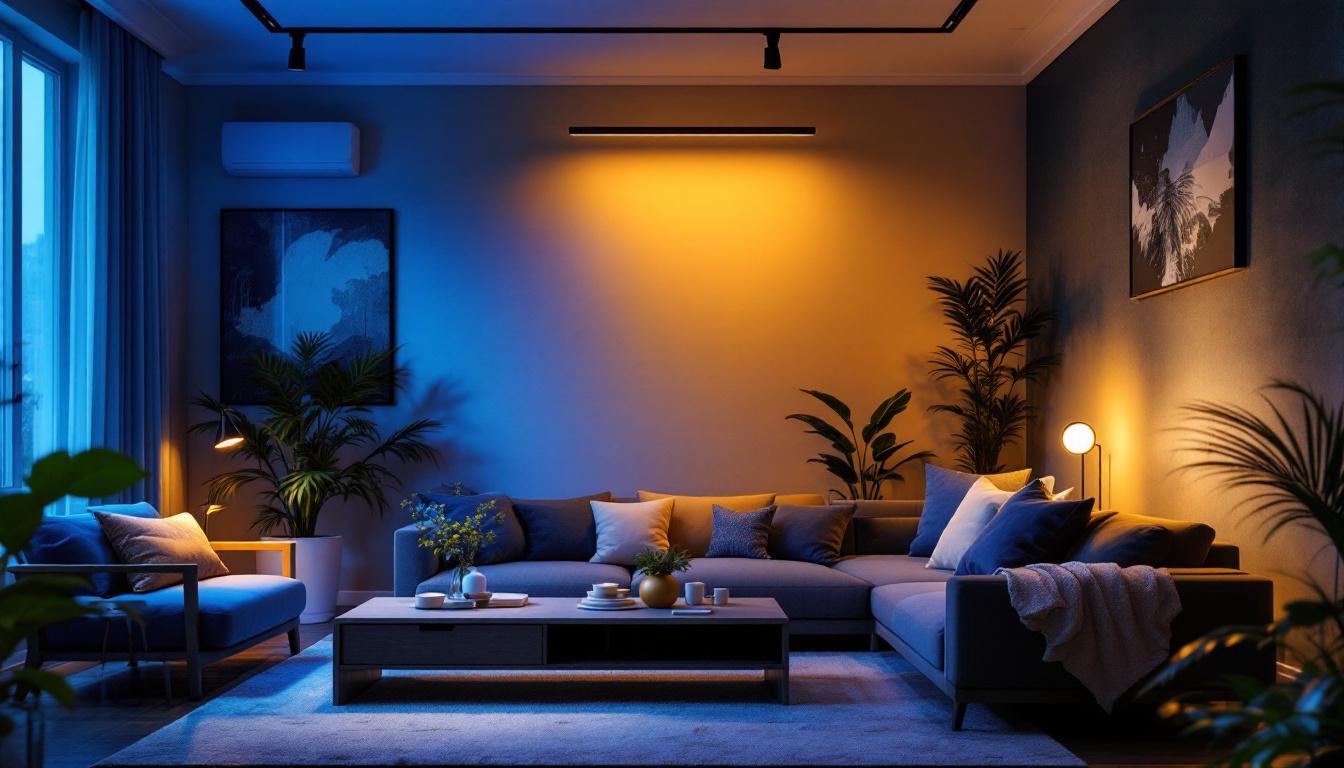
Color temperature is a critical factor in lighting design, influencing not only aesthetics but also functionality and occupant comfort. A 4000K LED lamp emits a neutral white light that sits between warm and cool tones. This middle ground makes it a versatile choice for various applications, from commercial spaces to residential areas.
For lighting contractors, grasping the nuances of 4000K lamps is essential. The color temperature affects how colors appear under the light, impacts mood, and even influences productivity. Unlike warmer 2700K or cooler 5000K options, 4000K strikes a balance that can suit many environments without being too harsh or too cozy.
In commercial settings, 4000K lighting is often favored for its ability to enhance visibility and detail, making it an ideal choice for offices, retail spaces, and showrooms. This color temperature helps create an inviting atmosphere while still promoting alertness and focus among employees and customers alike. For instance, in a retail environment, products can appear more vibrant and true to their color, which can significantly influence purchasing decisions. Additionally, 4000K lighting can be particularly beneficial in workspaces where precision is crucial, such as design studios or workshops, as it helps in reducing eye strain and improving overall comfort during extended periods of use.
Moreover, the use of 4000K LED lamps extends beyond just functional applications; they also play a pivotal role in enhancing the overall design aesthetic of a space. When incorporated into residential areas, such as kitchens and bathrooms, 4000K lighting can create a clean and modern look that complements contemporary decor. This color temperature is particularly effective in spaces where clarity and brightness are desired, allowing homeowners to perform tasks with ease while enjoying a pleasant ambiance. Furthermore, as energy-efficient LED technology continues to evolve, the longevity and lower energy consumption of 4000K lamps make them an attractive option for both new installations and retrofitting existing fixtures, aligning with sustainability goals in modern lighting projects.
One of the standout benefits of 4000K LED lamps is their ability to render colors accurately without distortion. This is particularly valuable in settings like offices, retail stores, and healthcare facilities where true color representation is crucial. A neutral white light helps reduce eye strain and enhances visibility, which can improve safety and efficiency.
Lighting contractors often find that 4000K lamps meet client demands for a professional yet inviting atmosphere. For example, in retail, merchandise appears more appealing under 4000K lighting, which can positively influence purchasing decisions. The psychological impact of lighting cannot be understated; studies have shown that customers are more likely to linger and explore products in environments that utilize well-balanced lighting, leading to increased sales and customer satisfaction.
Like other LED options, 4000K lamps offer significant energy savings compared to traditional incandescent or fluorescent bulbs. Their efficiency translates into lower operational costs for clients, an important selling point when proposing lighting upgrades. Additionally, LEDs have longer lifespans, reducing maintenance frequency and associated labor costs for contractors. This longevity is particularly beneficial in commercial settings where downtime can lead to lost productivity and revenue.
Energy codes and standards increasingly favor LED technology, making 4000K lamps a practical choice for compliance. Contractors can leverage this to position themselves as knowledgeable and forward-thinking, helping clients navigate regulatory requirements smoothly. Moreover, as sustainability becomes a priority for many businesses, the use of energy-efficient lighting solutions like 4000K LEDs can bolster a company’s green credentials, appealing to environmentally conscious consumers and stakeholders alike.
The neutral tone of 4000K lighting works well in a variety of settings. It’s bright enough for task-oriented spaces like workshops and kitchens but not so cool that it feels sterile. This flexibility means contractors can standardize on 4000K lamps for mixed-use projects, simplifying inventory and installation processes. In educational environments, for instance, the clarity of 4000K lighting can enhance focus and concentration among students, making it an ideal choice for classrooms and libraries.
Furthermore, 4000K LEDs integrate well with smart lighting controls and dimming systems. This compatibility enables contractors to offer advanced solutions that enhance user experience while optimizing energy use. The ability to adjust lighting based on the time of day or specific tasks not only improves comfort but also promotes energy conservation, allowing businesses to adapt their lighting to their needs dynamically. As smart technology continues to evolve, the integration of 4000K lighting with IoT devices can lead to innovative applications that further enhance operational efficiency and user satisfaction.
While 4000K is neutral, it can sometimes feel too cool for home environments that benefit from warmer lighting. Clients seeking cozy, relaxing atmospheres may find 4000K lamps less appealing. Lighting contractors need to manage expectations and possibly recommend warmer alternatives for bedrooms and living rooms.
Understanding client preferences is key. Some homeowners may appreciate the clarity and brightness of 4000K, especially in kitchens or garages, but it’s rarely the best choice for spaces intended for unwinding.
Not all 4000K LED lamps are created equal. Variations in manufacturing can lead to inconsistencies in color temperature and color rendering index (CRI). Contractors must source products from reputable manufacturers to ensure uniformity across installations.
Inconsistent lighting can detract from the overall quality of a project and lead to callbacks or client dissatisfaction. Testing samples before full installation is a prudent step to avoid these pitfalls.
While LED technology generally offers cost savings over time, 4000K lamps can sometimes carry a premium price compared to warmer or cooler LEDs due to their balanced spectrum and higher CRI ratings. This can affect project budgets, especially in large-scale installations.
Contractors should weigh the initial investment against long-term benefits like energy savings and client satisfaction. Transparent communication about these trade-offs helps build trust and justifies the choice of 4000K lamps.
Before specifying 4000K lamps, contractors should evaluate the intended use of the space, occupant needs, and aesthetic goals. For commercial projects focused on productivity and clarity, 4000K is often ideal. For residential or hospitality settings, a layered lighting approach might be better.
Site visits and consultations with clients can uncover preferences that inform the best color temperature choice. Offering samples or mock-ups can also help clients visualize the effect of 4000K lighting.
Color rendering index (CRI) measures how accurately a light source displays colors compared to natural light. For 4000K LEDs, a CRI of 80 or above is generally recommended to ensure good color fidelity. Higher CRI values enhance the quality of light but may increase cost.
Contractors should balance CRI requirements with budget constraints and project demands. In spaces like art galleries or medical facilities, a CRI closer to 90 or above might be necessary.
4000K LED lamps often perform best when paired with compatible dimmers and control systems. Lighting contractors should verify that the chosen lamps support dimming and integrate smoothly with building automation systems if applicable.
Ensuring compatibility prevents flickering, buzzing, or reduced lamp lifespan. It also allows contractors to offer clients advanced lighting solutions that enhance comfort and energy management.
A mid-sized corporate office upgraded its lighting to improve employee comfort and reduce energy costs. The contractor specified 4000K LED panels with a CRI of 85, balancing brightness and color accuracy. The result was a noticeable improvement in visual comfort and a 40% reduction in lighting energy consumption.
Employees reported less eye fatigue, and management appreciated the lower utility bills. The neutral white light complemented the office’s modern design, creating a professional atmosphere without feeling clinical.
In a clothing boutique, the contractor chose 4000K LED track lighting to highlight merchandise. The neutral color temperature enhanced fabric colors and textures, making products more attractive to shoppers. The LEDs’ long lifespan and energy efficiency also reduced maintenance and operational expenses.
The store owner noted increased customer engagement and sales after the lighting upgrade, attributing part of the success to the improved visual presentation enabled by the 4000K lamps.
A healthcare clinic required lighting that supported accurate color assessment and patient comfort. The contractor installed 4000K LED fixtures with a high CRI rating to ensure clinical tasks could be performed reliably. The neutral white light also helped create a clean, welcoming environment.
Staff appreciated the consistent lighting quality, which contributed to better diagnostic accuracy and patient satisfaction. The energy savings aligned with the facility’s sustainability goals.
Choosing the right color temperature is more than a technical decision; it’s about meeting client needs and enhancing the built environment. 4000K LED lamps offer a compelling option for many projects, blending functionality with aesthetic appeal.
However, contractors must consider the specific context, client preferences, and product quality to maximize the benefits. By doing so, they can deliver lighting solutions that perform well, comply with standards, and satisfy end users.
Ultimately, the success of using 4000K LED lamps depends on thoughtful specification, careful product selection, and clear communication throughout the project lifecycle.
Ready to enhance your lighting projects with the perfect balance of quality and value? Look no further than LumenWholesale for a comprehensive range of 4000K LED lamps and other spec-grade lighting products. Our commitment to providing contractors with superior lighting solutions at wholesale prices means you can achieve the ideal lighting environment for any space, without the burden of inflated costs. Plus, with free shipping on bulk orders, you can stock up on high-performance lighting effortlessly. Don’t compromise on quality or price—discover wholesale lighting at the best value today and bring your lighting projects to life with LumenWholesale.

Discover the ultimate guide to 8 ft LED shop lights, featuring expert insights from top lighting contractors.

Discover essential tips for lighting contractors to seamlessly install string LED lights outdoors.

Discover essential insights for lighting contractors on selecting and installing electrical box cover plates.

Discover the essential guide for lighting contractors on selecting the perfect dimmable LED canister lights.